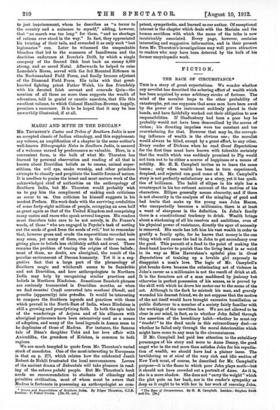MAGIC AND MYTH IN THE DECCAN.* MR. THURSTON'S Castes and
Tribes of Southern India is now an accepted classic of Indian ethnology, and this supplement- ary volume, an amplification of a chapter in the same author's well-known Ethnographic Notes in Southern India, is assured of a welcome earned by predecessors so valuable. Here, in a convenient form, is the bulk of what Mr. Thurston has learned by personal observation and reading of all that is known about Dravidian beliefs as to omens, animal super- stitions, the evil eye, snake worship, and other primitive attempts to classify and propitiate the hostile forces of nature. It is needless to praise the latest and most mature work of the acknowledged chief of authorities on the anthropology of Southern India, but Mr. Thurston would probably wish us to pay him the compliment of making such criticisms as occur to us. One criticism he himself suggests in his modest Preface. His work deals with the surviving credulities of some forty-eight millions of people, occupying an area half as great again as that of the United Kingdom and comprising many castes and races who speak several tongues. His readers must therefore take care to be not merely, in Dr. Frazer's words, of those "who are engaged in Psyche's task of sorting out the seeds of good from the seeds of evil," but to remember that, however gross and crude the superstitions recorded here may seem, yet many of them, even in the ruder races, are giving place to beliefs less childishly selfish and crueL There remains the problem of tracing the origins of these beliefs ; most of them, no doubt, are aboriginal, the result of the peculiar environment of Deccan humanity. Yet it is a sug- gestive fact that a large part of the phraseology of Southern magic and witchcraft seems to be Sanskritic and not Dravidian, and here anthropologists in Northern India may help by recognizing similar practices and beliefs in Northern Hinduism. Sometimes Sanskrit phrases are curiously transmuted in Dravidian mouths, as when we find imasani Candi converted into mashani Chendi, and grantha (apparently) into grdndha. It would be interesting to compare the Southern legends and practices with those which prevail in the North-East of India, where Hinduism is still a growing and proselytizing faith. In both the epic tales of the wanderings of Arjuna and of his alliances with aboriginal princesses have been extensively used as a means of adoption, and many of the local legends in Assam seem to be duplicates of those of Madras. For instance, the famous tale of Bana's daughter Usha, and her love affair with Aniruddha, the grandson of Krishna, is common to both regions.
We are much tempted to quote from Mr. Thurston's varied stock of anecdotes. One of the most interesting to Europeans is that ou p. 271, which relates how the celebrated Jesuit Robert de Nobili frustrated the local necromancers. Lovers of the ancient drama of Sakuntala will take pleasure in read- ing of the sakuna pakshi people. But Mr. Thurston's book needs no recommendation to students of ethnology and primitive civilization, most of whom must be aware that Madras is fortunate in possessing an anthropologist so com-
' Omens and Superstitions of Southern Tridis. By Edgar Thurston, C.I.E. London: T. Fisher Unwin. [12.s. 6d. net.]
petent, sympathetic, and learned as our author. Of exceptional interest is the chapter which deals with the Meriahs and the human sacrifices with which the name of the tribe is now inextricably associated. Every page, however, contains interesting and suggestive information, and in their present form Mr. Thurston's investigations may well prove attractive to readers who may have been deterred by the bulk of his former encyclopedic work.


































 Previous page
Previous page